Foods 1010 Lessons
| Site: | Joans-place |
| Course: | Foods |
| Book: | Foods 1010 Lessons |
| Printed by: | Guest user |
| Date: | Tuesday, 21 October 2025, 5:08 PM |
Description
Your lessons
How to do this Module
Everything you need to hand in for this lesson is included in this check list. Each of the lessons will teach a portion of what you need to complete items on the check list. Please hand in the checklist and all the photos once you have completed the module.
Foods 1010: Food Basics Check list
Checklist for Module Completion
In this Module you need to learn to handle food in a safe and sanitary manner and learn to use a recipe.
Check off each of the following when you have done them.
Here is a link to the Checklist in Word format
Here is a link to upload your completed work
| I washed my hands before working with food and have included a photo. | |
| I made sure my workspace was clean before I started and have included a photo. | |
| I have gathered the kitchen utensils, tools and ingredients needed for the recipe, before beginning and have included a photo. | |
| I have taken the WHMIS course | |
| I have looked at Eating Well with Canada’s Food Guide and completed the quiz. | |
| I have read the recipe and made measurements carefully | |
| I have prepared the food according to the recipe and have included a photo. | |
| I have ensured my workspace was clean after my cooking was complete and have included a photo. | |
|
I have had two people,(friends or family) test the food I have prepared. I have included their comments regarding the following questions: 1. Is the appearance of the food appetizing? 2. Does the food taste good? 3. Is there a suggestion for improvement? |
Safety in your kitchen
Lesson Questions
- What is important to make your kitchen a safe place for food preparation?
Lesson
Cooking should be an enjoyable and productive experience. To ensure that is the case it is important that you pay attention to safety in the kitchen.
Your tools
- Keep kitchen appliances clean and in good condition
- Follow instructions carefully when using stoves, ovens, microwave ovens, and other kitchen appliances
- Make sure your knives are clean and sharp
Fire prevention & safety
- Wipe up spilled grease as soon as the surface of the stove is cool
- Keep pot handles on the stove pointing to the back and always watch young children in the kitchen
- Don’t store items on the stovetop because they could catch fire
- Wear short sleeves and tie back long hair while cooking (this also keeps hair out of the food!)
- It’s wise to have a fire extinguisher near the kitchen; keep it 10 feet away from the stove on the exit side of the kitchen
- Never pour water on a grease fire; turn off the stove and cover the pan with a lid
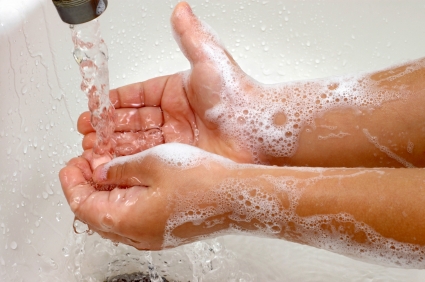
Cleanliness
- Handwashing is one of the best ways to prevent the spread of foodborne illness
- Wash your hands for at least 20 seconds with soap and warm water before handling food
- Keep countertop & workspace clean to reduce bacteria and can prevent foodborne illness
WHMIS Symbols - short course
The following is a summary of the WHMIS system and symbols.
 WHMIS is a short form for Workplace Hazardous Materials Information System. WHMIS is a Canada-wide system designed to ensure that all employers obtain the information that they need to inform and train their employees about hazardous materials used in their workplace. Information is provided by means of product labels, material safety data sheets (MSDS) and worker education programs.
WHMIS is a short form for Workplace Hazardous Materials Information System. WHMIS is a Canada-wide system designed to ensure that all employers obtain the information that they need to inform and train their employees about hazardous materials used in their workplace. Information is provided by means of product labels, material safety data sheets (MSDS) and worker education programs.
WHMIS labels provide the essential information that a person needs in order to handle a particular product safely.
MSDSs provide basic technical information about a product's physical characteristics and its hazardous properties.
Worker Education is that part of the program that ensures workers are able to apply the information to protect the personal health and safety
At this point in your school career, you likely be dealing with materials that are safe to handle. However, you should become familiar with the following WHMIS symbols. As you enter the workforce it is very important that you understand how to handle hazardous materials safely.
The WHMIS system groups hazardous materials into eight classes or categories based on the hazard that they represent. Each hazard has it is own symbol. In this activity you will investigate the symbols used in the workplace to identify hazardous or controlled substances.
What to do
Here is a Drag and Drop to help you learn these symbols:
Click here
Just drag the description to the symbol - feedback is immediate ~if you are right you will see a red check, if you are incorrect the description will bounce back
- Take a photo of your clean workspace.
- Take a photo of you wahing your hands with lots of soapy water
An organized workspace
Lesson Questions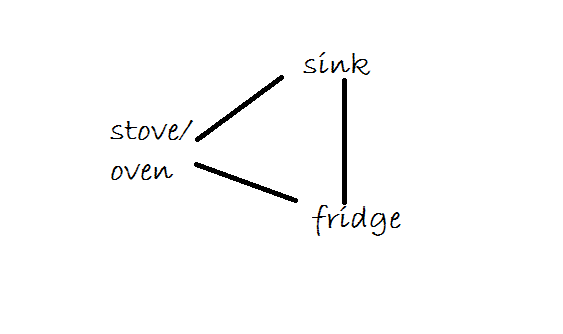
- How do you create an organized workspace in your kitchen?
Lesson
The kitchen work triangle
- connects your refrigerator, sink and stove in an effective way
- set up four main workspaces:
- preparation area
- cook area
- serve area
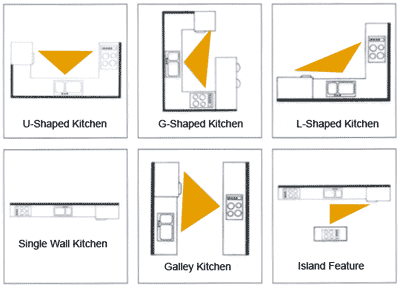
- clean-up area
- Organize your most important tools and ingredients around these key kitchen zones
- Keep useful items in each zone, for example storing your dishes and silverware between your cook and serve areas
The picture at right shows how work triangles look differently in different kitchens.
Mise en Place
The phrase 'mise en place' (pronounced 'miz on plas') is a French phrase which means 'everything in place' or 'putting in place'. It refers to all the preparation a cook does before starting to cook. It involves collecting all necessary ingredients for your recipe around your work surface (washed and chopped vegetables, cut meats, spices, liquids, dry ingredients, etc.), and gathering all necessary tools. It also encompases preheating ovens and getting out any other kitchen applicances that may be needed (blenders, food processors, etc.). Doing all of this in advance lets you focus on the cooking process instead of running around looking for ingredients while others burn in the pan. You do not necessarily have to put all of the ingredients in separate bowls, but do have them prepared and readily available, on a plate for instance, or in piles on a cutting board (keeping in mind the rules about raw meats!)
Here are some examples to give you an idea of what mise en place can look like:
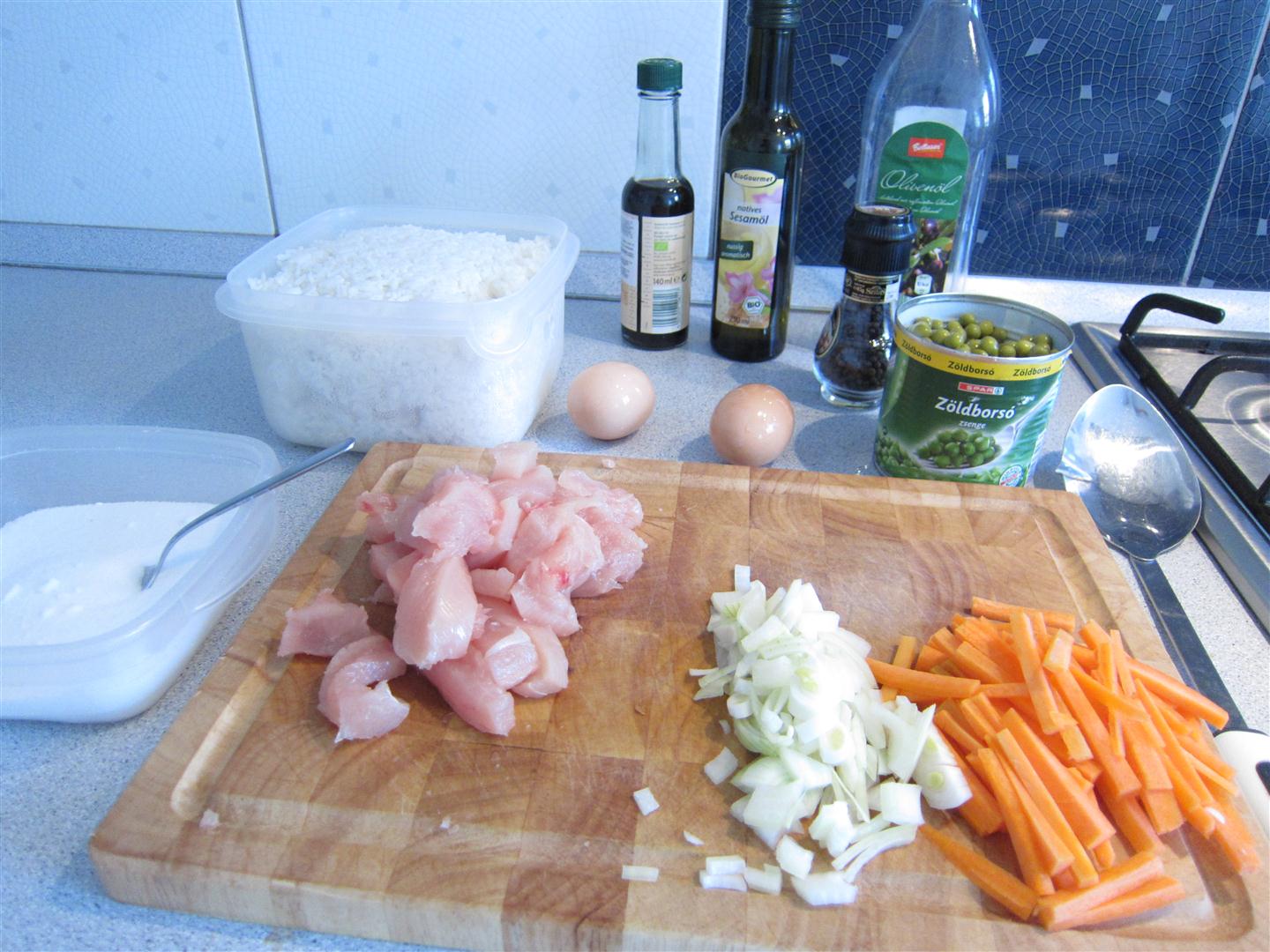

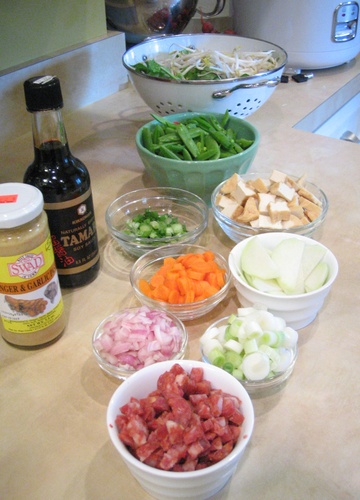
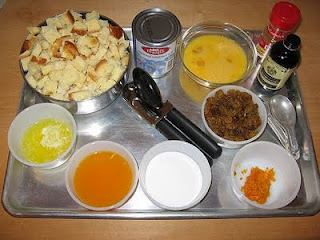
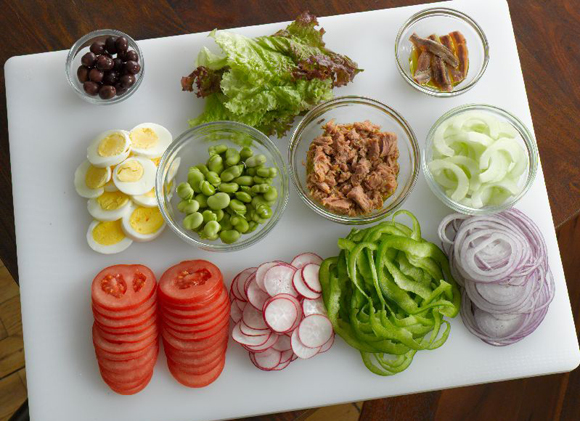
What to do
Take a photo of your workspace with all ingredients and tools needed to complete your recipe.
Sanitary food preparation
Lesson Questions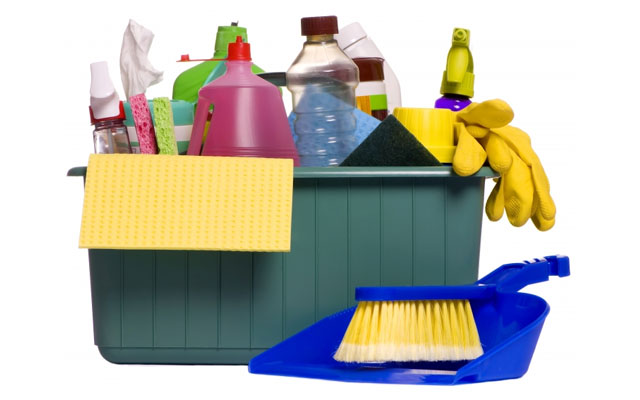
- How do you ensure safe sanitary practices in your kitchen?
Lesson
Why is food safety and sanitation so important? There are many foodborne illnesses from bacteria such as E. coli, Salmonella, Campylobacter, and Listeria (which can cause diarrhea, fever, abdominal cramps, nausea, vomiting, and dehydration). Without clean and sanitary kitchen practices, these can contaminate our foods. Happily, we can easily protect ourselves by ensuring hand washing (with plenty of soap) before and after handling food. For extra insurance, a sanitizer based on bleach can be used. If you don’t keep your hands, utensils and food preparation areas clean and sanitized, bacteria can spread easily. It can then contaminate your food.
BLEACH SANITIZER
- Combine 5 mL (1 tsp) of bleach with 750 mL (3 cups) of water in a labelled spray bottle
- After cleaning, spray sanitizer on the surface/utensil and let stand briefly
- Rinse with lots of clean water, and air dry (or use clean towels)
Safe kitchen practices:
- Use separate cutting boards:
- one for raw meat, poultry and seafood
- another for ready-to-eat and cooked foods
- Clean and sanitize cutting boards after each use
- NEVER cut cooked meat on a cutting board which was used to cut raw meat unless you have cleaned it thoroughly after cutting the raw meat

- Wash the lids of canned foods just before opening them to prevent dirt from getting into the food
- Take small appliances apart (food processors, meat grinders and blenders) right after you use them, and clean and sanitize them thoroughly
- Air dry dishes and utensils if you can, or dry them with clean kitchen towels
- Clean the pantry regularly, keeping food off the floor
- Store food in sealed containers
- Wash and sanitize containers and utensils that were in contact with raw food before you reuse them
- Use a food thermometer to measure the internal temperature of your food
- Wash raw fruits and vegetables with clean, running water before you prepare and eat them
Safe food preparation practices:
Chill food because disease-causing bacteria multiply quickly when food is kept at room temperature.
- Bacteria can grow in the danger zone between 4°C and 60°C (40°F to 140°F).
- To prevent the growth of harmful bacteria, keep cold food cold. Store it at or below 4°C (40°F).
- Do not keep food in the danger zone for longer than two hours. Foods that need to be refrigerated or frozen should be stored immediately after they are brought home from the grocery store.
- Refrigeration at or below 4°C (40°F) slows down most bacterial growth, while freezing at or below -18°C (0°F) can stop bacteria growth almost completely.
- Plan ahead: thaw food in the refrigerator, where the food will stay at a safe, constant temperature of 4°C (40°F) or below.
Separate raw food from other food because their juices can contain harmful bacteria that can contaminate other food.
- Bacteria can be carried in raw meat juices. So keep raw food away from other food while shopping, and while storing, preparing and serving foods.
- Place raw meat, poultry and seafood in containers on the bottom shelf of the refrigerator. This will prevent raw juices from dripping onto other food or touching other food.
- Use separate equipment and utensils such as knives and cutting boards for handling raw foods.
- When serving cooked food, do not reuse the same plates and utensils that raw food sat on. Use clean plates and utensils for cooked and other ready-to-eat food.
Cook foods thoroughly to a safe internal temperature to prevent foodborne illness
- Bacteria can grow in the danger zone between 4°C and 60°C (40°F to 140°F).
- Keep hot foods at or above 60°C (140°F).
- Make sure that sauces, soups and gravy are brought to a boil when you reheat them.
- When cooking food in a microwave, stir or rotate the food half way through the cooking time. This will eliminate any cold spots and will help with even cooking.
- Use a digital food thermometer to check that the temperature of cooked foods has reached the safe temperatures
Canada's Food Guide
Lesson Questions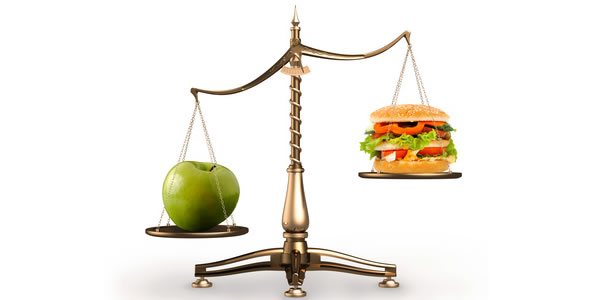
- How do you make healthy food choices??
Lesson
In our country, the best source of information about healthy food choices is the Canada Food Guide
Click here for Eating Well with Canada's food guide
What to do
Here is a link to a short quiz that will help you assess how familiar you are with Canada's Food Guide.
Following a recipe
Lesson Questions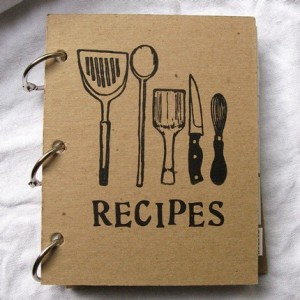
- Demonstrate that you can follow a recipe to cook a food of your choice.
Lesson
The kitchen work triangle
- connects your refrigerator, sink and stove in an effective way
- set up four main workspaces:
- preparation area
- cook area
- serve area
- clean-up area
- Organize your most important tools and ingredients around these key kitchen zones
- Keep useful items in each zone - for example, storing your dishes and silverware between your cook and serve areas
Getting Ready to Cook
- take some time to organize your recipes, cook times, ingredients and tools.
- setting out tools and ingredients before cooking starts will help cooking proceed more smoothly
- Keeping your knives sharp is safer and will cut your preparation time in half.
- If you need to cook several side dishes at once, choose casseroles that fit into your oven with spaces in between to ensure good airflow
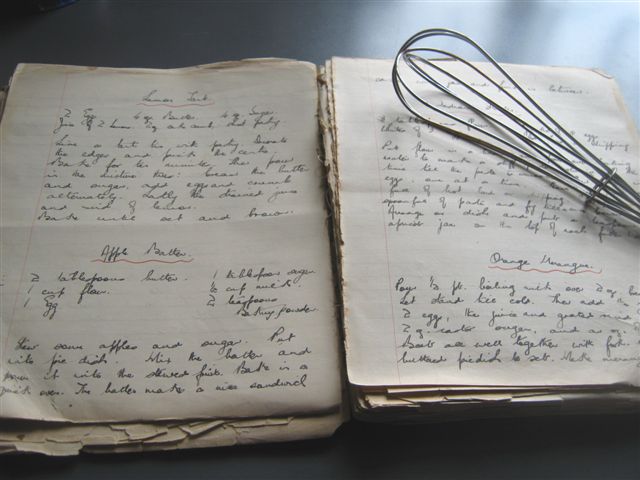
Read the Recipe
- check to make sure you have all of the required ingredients
- make sure you have all the appliances & tools or a reasonable substitute
- pay attention to the timelines described in the recipe
Prepare Ingredients and Utencils (Mise en place!)
- have all of your kitchen tools set up, and ready to use
- pre-measure ingredients into bowls or dishes so they're ready to use
- many cold ingredients should come to room temperature before you use them
- if the recipe calls for yeast prepare it ahead of time in a small bowl so you can just add it when needed
- preheat your oven when baking
- preheat your pan if you are frying or using oil
- fruits and vegetables should be chopped, sliced, diced, before you begin
- before cooking meats, trim away excess fat and remove bones from fish and poultry
- set up appliances like electric mixer, food processor, deep fryer, or blender before you begin
Following the Recipe
- the first time you use a recipe, follow each instruction exactly as written
- it's best not to double or reduce the recipe unless you have tried it before and you are sure it works.
What to do
Use a recipe to cook a food of your choice.
